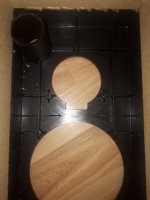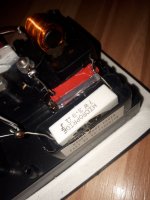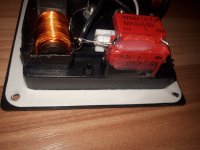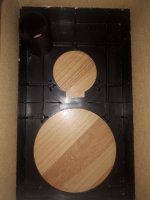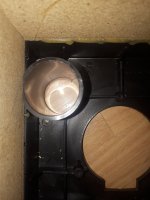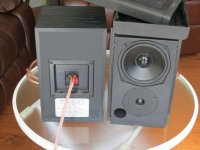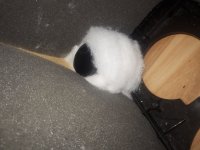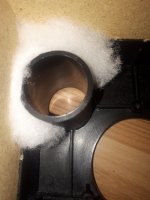Agreed, sounds exactly like port noise. Anything within a few cm of the end of the port on the inside could lead to more chuffing than the other speaker.Playing back on my crappy computer speakers, that sounds like port chuffing. Have you looked for differences in and around the ports between the speakers? Obstructions, looseness, burrs, damping material in the way, etc.?
Loose solder joint on the bass shunt capacitor in the crossover, I would guess:
https://www.ebay.co.uk/itm/153756243036
Causes horrible crackling noises.
https://www.ebay.co.uk/itm/153756243036
Causes horrible crackling noises.
Tried switching channels on the amp but it didn't help. Stuffing the speaker cabinet with polyester wadding made crackling disappear.
Tried taking some pictures of the speakers cabinets from the inside. Also got the electrolytic caps changed, but as expected it didn't help to get rid of the noise.
Tried taking some pictures of the speakers cabinets from the inside. Also got the electrolytic caps changed, but as expected it didn't help to get rid of the noise.
Attachments
Not what my hearing tells me.Agreed, sounds exactly like port noise.
Last edited:
Not my first guess but it does point to something inside the cabinet or something that is reduced by increasing the cabinet pressure.Loose solder joint on the bass shunt capacitor in the crossover,
Not something I would have suggested. Your sound clip indicates something else, at least to my ears. Hence the stethoscope idea.Also got the electrolytic caps changed, but as expected it didn't help to get rid of the noise.
If adding some polyester damping fixed it, just doing that to both speakers may be the sensible approach.
It's hard to make out the edge detail, but it looks like the healthy one may have had the internal inside edge of the port deburred/chamfered, and the crackler may not have. You can probably reach in through the woofer hole and feel for that difference.
It's hard to make out the edge detail, but it looks like the healthy one may have had the internal inside edge of the port deburred/chamfered, and the crackler may not have. You can probably reach in through the woofer hole and feel for that difference.
The port walls seem to be a bit thinner on the healthy one and the inside edge is a little bit smoother to the touch, but can it have such massive effect on the sound? I reached in through the terminal/xover cup hole.If adding some polyester damping fixed it, just doing that to both speakers may be the sensible approach.
It's hard to make out the edge detail, but it looks like the healthy one may have had the internal inside edge of the port deburred/chamfered, and the crackler may not have. You can probably reach in through the woofer hole and feel for that difference.
It's hard to say with certainty from a distance.
It doesn't take much of a defect in the air flow to make quite a bit of noise though, especially if the port is a little under sized anyway. The surest way to tell in the end is probably to try to debur it and see if the problem goes away.
It doesn't take much of a defect in the air flow to make quite a bit of noise though, especially if the port is a little under sized anyway. The surest way to tell in the end is probably to try to debur it and see if the problem goes away.
This is what port noise sounds like when playing a constant tone. It's quite different to what it sounds like when playing music.Not what my hearing tells me.
If you have changed all components from one cabinet to the other and the sound stayed with the cabinet, it is the cause. Must be.
I would glue the plastic part to the wood with some epoxy or polurethane wood glue (it foams during curing and stays elastic).
This should fix it.
If you wanted to go scientific, the impedance measurement of both boxes, with open and closed port, should show differences and give a hint what kind of cause the sound has. When the plastic is loose or some other gap exists, the closed measurements should show two bass peaks instead of one, for a real closed box.
Glueing everything over should be less time consuming...,
I would glue the plastic part to the wood with some epoxy or polurethane wood glue (it foams during curing and stays elastic).
This should fix it.
If you wanted to go scientific, the impedance measurement of both boxes, with open and closed port, should show differences and give a hint what kind of cause the sound has. When the plastic is loose or some other gap exists, the closed measurements should show two bass peaks instead of one, for a real closed box.
Glueing everything over should be less time consuming...,
Not sure how to say this other than I believe you are wrong. I have a set of 760i's.It's quite different to what it sounds like when playing music.
Blue Venom, do what the speaker detectives do and either build or acquire yourself a stethoscope and save yourself, and us, a bunch of time. I am guessing less than five minutes.
Attachments
Perhaps somewhere the glue of a joint has gone? Or the glue holding the port has partially gone. I've had some new speakers delivered and there was an annoying peak of approximate 400 Hz in one of them: one of the inductors on the crossover had slid down and was rubbing against the lead of a capacitor. And the crossover in the LS3/5A has a felt pad underneath it to stop it vibrating.
Was reading through this thread and was about to say I had a strange noise coming from my Kef Coda 8s years ago. I found the port had come unglued from the side wall, and the plastic port was rattling against it.
Putting sintepon just around the port made crackling disappear, and now i can hear at 50hz that the healthy speaker actually chuffs just a little bit more.
I spent ages testing different stuffing types and positions in a pair of speakers once, and found the only place that didn't have a negative impact on port output was directly around the port (I didn't try covering the whole port like you, though).
My guess is by putting stuffing around the end of the port, you've done something similar to rounding it over. A trick used to reduce port chuff.
It also perfectly works if i stuff just the crevice, to see whats going on in that crevice i'd probably need an endoscope camera, but i wont bother, got to enjoy them now 😊Was reading through this thread and was about to say I had a strange noise coming from my Kef Coda 8s years ago. I found the port had come unglued from the side wall, and the plastic port was rattling against it.
Attachments
By plastic part you mean ply the whole front plastic part off and glue it back or glue just the front port from the cabinet inside to the wood?If you have changed all components from one cabinet to the other and the sound stayed with the cabinet, it is the cause. Must be.
I would glue the plastic part to the wood with some epoxy or polurethane wood glue (it foams during curing and stays elastic).
This should fix it.
If you wanted to go scientific, the impedance measurement of both boxes, with open and closed port, should show differences and give a hint what kind of cause the sound has. When the plastic is loose or some other gap exists, the closed measurements should show two bass peaks instead of one, for a real closed box.
Glueing everything over should be less time consuming...,
Bit of a long shot, but could it be voice-coil rubbing?
Rotate the bass 90 or 180 degrees to help.
If a voice coil rubs, you can usuallly hear a scraping noise on pressing the cone in with your fingers.
Rotate the bass 90 or 180 degrees to help.
If a voice coil rubs, you can usuallly hear a scraping noise on pressing the cone in with your fingers.
I haven't tested a port that won't chuff at least bit when played with a pure tone at high enough volume. Chuffing happens when flow becomes turbulent, which starts fairly suddenly above a certain air velocity specific to the precise port design. Port air velocity peaks dramatically around the tuning frequency, (example graph below). In practice, if mitigate chuffing to a certain level it ceases to become a problem on most music, (movies are a different matter).It also perfectly works if i stuff just the crevice, to see whats going on in that crevice i'd probably need an endoscope camera, but i wont bother, got to enjoy them now 😊
I'd take a bit of sandpaper, round over the lip on the inside end of the ports, apply your wadding solution to both speakers. Then sit back and enjoy the music. At that point you are probably experiencing better performance than most 760i users out there 😀
- Home
- Loudspeakers
- Multi-Way
- Mystery Mission 760i failure
